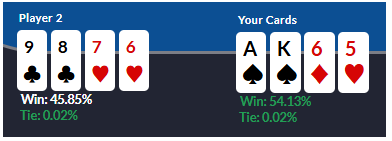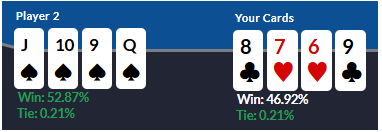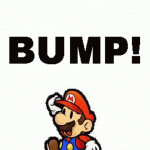CRStals
Moderator
Moderator
In the first part of our series, we went though some fundamental differences between Texas Hold’em and Pot Limit Omaha (PLO). Now in part two, we are going to dive deeper into the Mechanics of Pot-Limit Omaha (PLO). Let's get started.
Pre-Flop Play
Hand selection in Omaha is critical just like it is in any other variant of poker. But you can't follow the same guidelines for pre-flop play in Omaha that you do for Texas Hold'em. For instance, pocket pairs in Pot-Limit Omaha have nowhere near the strength pre-flop as connected and suited hands do. With that in mind, let's take a look at the hands below. Which hand is stronger preflop?
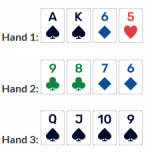
Hand 2 is the strongest but why?
Let's break this down - lets say we have two hands heads-up - AAKK double suited, and T987 double suited in the other two suits. Heads-up the odds look like this:
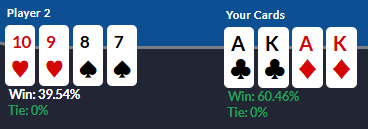
The double paired hand has a sizable equity advantage. However, let's add two other random hands into the mix:

Notice how the connected & suited hand's equity dropped 11.75% while the AAKK double suited hand dropped 21.85% - almost double the connected hand, even with only having 2 flush outs taken? Having options post flop in PLO is going to lead to more equity, especially with more hands in play pre-flop.
Let’s go back to those three hands to illustrate this point even more. Below are four examples – one with the three hands together and then three scenarios with two hands pitted against each other:
Hand #1

Hand #2

Hand #3

Hand #4

What is the first thing you notice? The more hands in play, the better connected and double suited hands play but heads-up, the better bigger cards play pre flop. Some pointed out that there are PLO hand rankings out there but there are reasons why hand rankings in PLO are much more volatile to follow. What do we mean by that? Well, the margins are a lot closer. Here are some examples:
Don’t take this the wrong way – this is not a call to be more active pre-flop in Omaha. In fact, this is a call to be more patient and aware pre-flop because with every hand that enters the pot, your equities will all move closer together. It’s the flop that will really set the stage for who has the best chance to win the hand.
Post Flop
One of the unique aspects of PLO is the hand strength changing street to street because the hole cards you use to make your best 5-card hand can (and often do) change. Here’s an example of your hole cards changing street to street to illustrate this point:
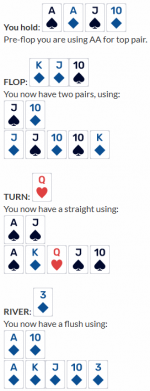
As you can see, being focused on just two-hole cards in PLO is short sighted because of the possibilities your hand could have later in the pot. These additional hand possibilities can have a big impact on your decisions earlier in the hand when it comes to implied odds.
What are Implied Odds?
Implied odds is the ratio of the possible or likely amount we will win relative to the cost of calling. And while we may not be able to exactly pinpoint how much we might win, PLO gives one advantage that Hold’em can’t: betting pot.
In PLO, we know the maximum that any player can bet at any given point in the hand: the size of the pot. This ceiling restricts the amount a player can technically lose if they decide to simply call and not raise to showdown, which can make calculating implied odds much easier for both players. A player may not want to call off their entire stack but, might call pot sized bets to showdown. Depending on the type of player you are against in a hand, this cap can prove to be a blessing or a hindrance, by letting players call down knowing what they have to invest to try and get there by showdown. Those that like to try and get there will often call and this can be difficult to combat knowing that they will not have to go broke in a hand to try and hit one of their outs.
In short, Pot Limit Omaha is a poker game where the action changes on every street and the betting is typically more intense than in Hold’em even though you can only bet pot.
Next week get ready for lesson #3: Pot-Limit Omaha Hi/Lo Unpacked
This has been a part of our CardsChat Learning Poker Thread Series. Be sure to check out and subscribe to our CardsChat Learning Poker Thread Series Index so you don't miss a new series or chapter!

Pre-Flop Play
Hand selection in Omaha is critical just like it is in any other variant of poker. But you can't follow the same guidelines for pre-flop play in Omaha that you do for Texas Hold'em. For instance, pocket pairs in Pot-Limit Omaha have nowhere near the strength pre-flop as connected and suited hands do. With that in mind, let's take a look at the hands below. Which hand is stronger preflop?

Hand 2 is the strongest but why?
- Multiple straight opportunities: It can make a straight from queen high, all the way down to 7 high: six total possible straights
- Double suited: Being double suited (holding two different suits, and only two suits) gives it the ability to make a club or diamond flush. Since you have two cards of each suit, you don’t block your ability to hit one flush or the other.
- No pocket pairs: Avoiding pairs gives you more opportunities to get two pairs or a full house with any combination of your hole cards: again, rarely does one pair or a high kicker ever win at showdown in Omaha.
- Less straight options: You have a lot of options to hit a straight being fully connected, but you can only make five possible straights, unlike the middle hand's six possible. You can make an ace high, king high, queen high, jack high and ten high straights; you can’t make a 9 high because you must use two hole cards.
- Smaller flush opportunities: You are less likely to hit a flush because you only have spades, but compounding that is you hold two spades that you cannot use, thus reducing your odds of getting there in the end with only nice usable spades left in the deck.
- Pairs and full house potentials: You can hit two pairs and full houses just like the middle hand, but remember - hitting top pair in Omaha is very rarely going to be enough to win.
- Less draw capabilities: For starters, you only have one combination that is powerful to play pre-flop:

- AK can only make an ace high straight, while the 56 can hit anything from a nine high to a six high: five straights in total. This is not as many as the middle hand, again, restricting the ability to win the pot post flop by the cards that could come.
- Fewer flush possibilities: You can only hit a spade flush (we aren’t blocking our odds to doing so), or hope to hit two pairs or full houses.
Let's break this down - lets say we have two hands heads-up - AAKK double suited, and T987 double suited in the other two suits. Heads-up the odds look like this:

The double paired hand has a sizable equity advantage. However, let's add two other random hands into the mix:

Notice how the connected & suited hand's equity dropped 11.75% while the AAKK double suited hand dropped 21.85% - almost double the connected hand, even with only having 2 flush outs taken? Having options post flop in PLO is going to lead to more equity, especially with more hands in play pre-flop.
Let’s go back to those three hands to illustrate this point even more. Below are four examples – one with the three hands together and then three scenarios with two hands pitted against each other:
Hand #1
Hand #2
Hand #3
Hand #4
What is the first thing you notice? The more hands in play, the better connected and double suited hands play but heads-up, the better bigger cards play pre flop. Some pointed out that there are PLO hand rankings out there but there are reasons why hand rankings in PLO are much more volatile to follow. What do we mean by that? Well, the margins are a lot closer. Here are some examples:
- AAKK double suited is a 60% favorite against a hand like 9876 double suited – it’s slightly better than a coin flip.
- 9876 double suited is a 58% favorite against a hand like T642 double suited – the odds are marginally closer to a coin flip.
- AAKK double suited only improves to a 63% favorite against a hand like T642 double suited.
- AAKK double suited is a 70% favorite against a hand like QT53 all one suit – or all four suits.
Don’t take this the wrong way – this is not a call to be more active pre-flop in Omaha. In fact, this is a call to be more patient and aware pre-flop because with every hand that enters the pot, your equities will all move closer together. It’s the flop that will really set the stage for who has the best chance to win the hand.
Post Flop
One of the unique aspects of PLO is the hand strength changing street to street because the hole cards you use to make your best 5-card hand can (and often do) change. Here’s an example of your hole cards changing street to street to illustrate this point:

As you can see, being focused on just two-hole cards in PLO is short sighted because of the possibilities your hand could have later in the pot. These additional hand possibilities can have a big impact on your decisions earlier in the hand when it comes to implied odds.
What are Implied Odds?
Implied odds is the ratio of the possible or likely amount we will win relative to the cost of calling. And while we may not be able to exactly pinpoint how much we might win, PLO gives one advantage that Hold’em can’t: betting pot.
In PLO, we know the maximum that any player can bet at any given point in the hand: the size of the pot. This ceiling restricts the amount a player can technically lose if they decide to simply call and not raise to showdown, which can make calculating implied odds much easier for both players. A player may not want to call off their entire stack but, might call pot sized bets to showdown. Depending on the type of player you are against in a hand, this cap can prove to be a blessing or a hindrance, by letting players call down knowing what they have to invest to try and get there by showdown. Those that like to try and get there will often call and this can be difficult to combat knowing that they will not have to go broke in a hand to try and hit one of their outs.
In short, Pot Limit Omaha is a poker game where the action changes on every street and the betting is typically more intense than in Hold’em even though you can only bet pot.
Next week get ready for lesson #3: Pot-Limit Omaha Hi/Lo Unpacked
This has been a part of our CardsChat Learning Poker Thread Series. Be sure to check out and subscribe to our CardsChat Learning Poker Thread Series Index so you don't miss a new series or chapter!

Attachments
Last edited:









